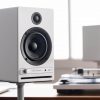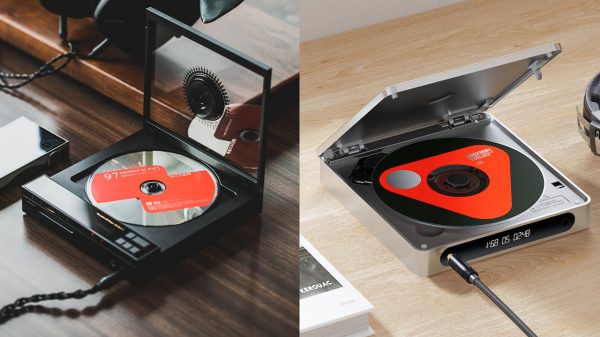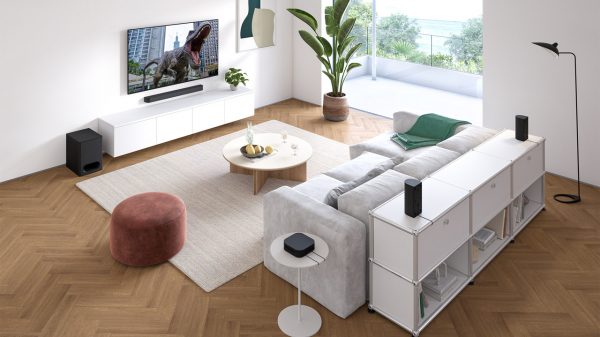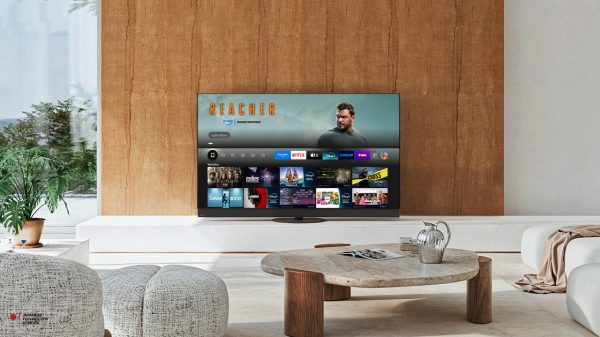Technics has had a long and storied history as a brand. Launched in 1965 as a HiFi moniker under parent company Matsushita (now known as Panasonic), Technics’ first product was a humble two-way loudspeaker. But the company really made its mark in the turntable market starting in 1970 with the release of its first direct drive turntable, the Technics SP-10. The SP-10 begat the SL-1100 and then the legendary SL-1200 which became the favorite of DJs and audiophiles alike. To date, the SL-1200 turntable, in various incarnations, has sold in the millions and evolved over time into more and more impressive versions of itself. Today you can buy a special edition Technics SL-1200M7B direct drive turntable in Lamborghini colors for the reasonably affordable price of $1599. But this story is not about turntables.
As Technics’ business and notoriety grew, the brand expanded into more market segments: CD players, compact HiFi systems, stereo receivers, more speakers, more turntables… even headphones. But as electronics gear became more commoditized and the heady days of HiFi enthusiasm waned, so did the Technics brand.
In 2010, Technics seemingly called it quits, only to rise again like a Phoenix from the ashes in 2014 with an impressive selection of high performance HiFi gear. For its 50th Anniversary in 2016, the SL-1200 was re-born in an enhanced SL-1200G version for a new generation of music lovers and audiophiles. I got a chance to check out the company’s $65,000 reference system last month in Kyoto, Japan and was impressed by what I heard. A few years later in 2020, the brand went after the highest selling (and most competitive) segment of the audio market: true wireless earbuds.

Hey, There, Little Bud
The company’s first effort in the true wireless earbud space, the AEH-AZ70, garnered some critical acclaim, earning praise for its accurate and engaging sound quality, but it faced some tough competition from the likes of Bose, Sennheiser, Sony and even Apple when it came to the effectiveness of its noise-cancelation.
I auditioned their upgraded 2023 model, the EAH-AZ80 and really enjoyed my time with them. They offer a nice compact form factor, a comfortable fit, excellent midrange and treble reproduction as well as a cohesive soundstage that extends wider and deeper than most buds I’ve listened to. It also offers improved, but still below class-leading, noise cancellation. While the bass response on the AZ80 is solid, they don’t offer the deep bass extension that I crave when I put on my favorite rock or EDM tracks. Don’t get me wrong: I’m no bass-head. But I do like to feel and hear that rhythm section in a meaningful and substantial way, even when listening to a tiny pair of buds in my ear. The AZ80s do have their fans, and I’m one of them. But those who are looking for “just a bit more” are about to get happy.

Hello, Hundo!
The number 100 has a special significance to many: a difficult task, finally achieved; a crisp 100-dollar bill; perfect IVs on that elusive Pokémon or really anything in life that reaches its ultimate potential. So by naming its new true wireless earbud the EAH-AZ100 – or to be brief – the AZ100 – Technics is setting a high bar. Can it live up to it? We shall see.
Features and Set-Up
Like most headphone brands, Technics offers its own headphone app. I use so many of these, I can never seem to find the one I need on my phone’s app list. Sony’s is called “Headphones” – no wait, they changed it to “Sound Connect.” Ugh. Bowers and Wilkins calls theirs “Music” but it does also include the brand name in the app (yay!). The Technics app is called “Audio Connect” which I never remember (why not put “Technics” in the name?). But at least it has the Technics logo in the app thumbnail and it starts with “a” so it’s easy enough to find alphabetically. And find it you should because it’s one of the more useful of the headphone apps.

For the AZ100, Technics’ Audio Connect app allows you to adjust the equalization (EQ) across not just 3 bands, not just 5 bands, but 8 separate bands. There are dedicated sliders for low bass all the way up to 12 KHz. You can also choose from preset EQ curves like “Dynamic,” “Treble+,” “Bass+” or “SuperBass+” (too bassy for me, though I’m sure there are some who will like this setting). The app is also where you enable Adaptive Noise Cancellation. And this is where the AZ100s give the big boys a run for their money.
Noise cancellation is great when it comes to reducing background noise on a train or in an airplane. But it’s all for naught if the noise cancellation also impacts the sound of the music you’re listening to. With the AZ100’s Adaptive Noise Cancellation engaged, I noticed a steep drop-off in background noise without a corresponding decrease in musical sound quality. And for those more sensitive to the artifacts of noise cancellation, the Technics app allows you to dial in a precise level of ambient noise suppression so you can find the sweet spot where external noises are reduced without any audible impact to the music.
Call quality has also been improved thanks to 3 microphones in each earpiece and Technics “Voice Focus AI” feature. This feature identifies vocal sounds both on the sending and receiving end and isolates these from background noises, both variable and steady state. At a demonstration of the technology, we took a call from someone in a simulated airplane cabin, with loud fans running inside an isolation booth. On the call, we could hear the voice, but not the fans. In my own use, I’ve also noticed exceptional call quality and those receiving my calls have also remarked on how quiet and clear things have sounded even when I was talking in noisy environments.
Both earbuds support touch control to adjust functions such as noise cancellation mode, playback control and volume. Specific functions can be customized in the app.

Connections R Us
The EAH-AZ100 supports Bluetooth 5.3 including the new Bluetooth LE Audio standard and Auracast features to pair and share audio, as well as the LC3 codec for low-latency audio when gaming and viewing videos. Audiophiles on the Android platform will be happy to see LDAC support and the AZ100s are also compatible with Google Fast Pair for near instantaneous pairing to any compatible Android phone. The AZ100s support instant switching among three independent devices, sensing and switching to whichever device becomes active. We tested this with a laptop, tablet and phone and found that switching among devices was quick and seamless. Of course, the AZ100s are also fully compatible with Apple devices (AAC and SBC) for those looking for an audiophile alternative to the ubiquitous white buds.
Battery Life and Fit
The AZ100s come with five different size ear tips, from extra small to large, in order to provide the snuggest fit for the greatest variety of ear shapes. In my case, the default “Medium” size fit me comfortably and securely. A secure fit is important for bass response and noise isolation so definitely experiment to figure out which tip fits you best. The AZ100s weigh only about 0.21 ounces (5.9 grams) which helps them to rest comfortably in the ears.

As for battery life, the AZ100 earbuds are rated for up to 10 hours of playback (AAC codec) on their own with active noise cancellation engaged. Bring along a fully charged case and you’ll get a total of 28 hours of playback. If you’re using the LDAC codec on a compatible Android devices, battery life may drop to around 7 hours due to higher bandwidth wireless transmission. The case is compatible with Qi
Wireless Charging or a wired USB-C connection (cable included). From 0% you can charge the headphones to full in about 2 hours, charge the case alone in 2.5 hours or charge both together in about 3 hours. a 15-minute quick charge of the earbuds in the case will get you around 90 minutes of playback time with ANC (AAC).
It’s the Fluid, Man
While noise cancellation and connectivity are important, the new AZ100s feature a more significant design improvement over their predecessors: an entirely new driver featuring the company’s “Magnetic fluid” design. Just like a speaker, the tiny voice coils and drivers inside an earphone vibrate in order to make sound. If these vibrations wobble off axis (which they can, in a traditional earphone driver) then distortion is introduced, muddying the sound.

The driver on the AZ100 is modeled after the company’s much more expensive wired in-ear monitor, the EAH-TZ700 ($1,200/pair at Amazon). Like the TZ700, the AZ100 use an oily magnetic fluid inside the driver to maintain rigid control of the driver’s movement. This ensures linear driver excursion and a reduction in audible distortion. It also helps the driver extend its frequency response below human hearing.
It’s the Sound, Man
Technics’ slogan is “Rediscover Music.” And I have to say, that’s what I’ve been doing since I got this pair of AZ100s in for review. I’ve been plowing through playlists on TIDAL and QOBUZ, listening to my favorite tunes all over again. Whether it’s Dolby Atmos music cuts on TIDAL or High Res Audio and lossless tracks on QOBUZ, the AZ100s have kept my ears perked up and my toes tapping as I’ve enjoyed tracks I haven’t listened to in months, or even years.
Listening mostly to alternative rock, folk, singer/songwriter fare and a smattering of jazz and classical, I haven’t found any particular genre of music that let me down on the AZ100s. Recently I’ve gotten into EDM, with one of my favorites being the 2023 album “Kx5,” a collaboration of Kx5, deadmau5 and Kaskade. The track “Alive” features a complex layering synths and a driving drum beat, accented by simple vocals. This tune comes alive on a great set of speakers or headphones, but few in-ear phones can do justice to the driving low bass. The Technics AZ100s knock this track out of the park, sonically speaking.

It’s not just the frequency response that stands out: yes, the highs are crisp and detailed without harshness, male and female vocals sound warm and natural, and bass is taut, full and extended – significantly better than their predecessor, the AZ80. In fact, it’s the tautness and extension of the low bass that left the biggest impression on me. I’ve never heard bass response of this quality in a pair of in-ear ‘phones. Even when you turn up the low bass in the EQ, the AZ100s retain their composure. But beyond the accurate tonal balance, it’s the details on the AZ100 that are overflowing. I can hear layers in the music that have been obscured on lesser headphones and earbuds.
Listening to the recent Dolby Atmos remixes of the Rush Albums “Moving Pictures” and “Signals” on TIDAL on the AZ100s, I’ve noticed subtle differences in Geddy Lee’s vocal inflection on some songs, compared to the classic stereo mixes. This made me realize that the engineer Richard Chycki actually used alternate vocal takes in some cases when he returned to the original multi-track master takes for the Dolby Atmos remixes. I’ve listened to these songs many times previously and never picked up on this before.
And speaking of Dolby Atmos, the AZ100 ‘phones do say right on the package that they’re “Optimized for Dolby Atmos.” Although I’ve never been too impressed with the sound of Dolby Atmos music through headphones (compared to speakers), the AZ100s do present a reasonable sense of spaciousness when listening to Dolby Atmos content. Also, the AZ100s are the first earphones I’ve tested that support head tracking, independent of the source hardware. In other words, there are Apple earphones and headphones that support head tracking with Apple devices, and there are Samsung earbuds that support head tracking with Samsung phones. But the Technics AZ100s support head tracking with both Samsung and Apple phones.

I tested out the head tracking feature on Dolby Atmos music tracks from TIDAL and found the experience pretty trippy. Just like in real life, when you turn your head from left to right, the sound stays in “front” of your body – the soundstage stays in the same virtual space even when you turn your head back and forth. I can imagine that this would be extremely useful to maintain positional awareness while gaming or when using AR or VR headsets. But in regular everyday music listening, it’s a bit distracting. Also, enabling “Spatial Audio” in the Technics headphone app gives the sound a slightly darker tone compared to regular playback. Fortunately both “Spatial Audio” and “Head Tracking” can be disabled if you prefer (both are turned off by default).
As far as imaging on traditional stereo music, the AZ100s present a wide stage extending well beyond the ears on both sides. On Aoife O’Donovan’s “Prodigal Daughter” High Res Audio stereo mix on QOBUZ, the first guitar is positioned on the wide left, while drums and bass guitar are nicely centered, each occupying its own space and the second guitar is wide on the right. Lead vocals appear front and center while the backup singer’s voice comes from slightly further back in the stage. Each voice stands apart from each other while effortlessly blending together.
Of course, you’re never going to get that wide deep soundstage of a great pair of speakers, a set of open-backed planar phones or a full surround sound system, but the AZ100s present a cohesive image that is fuller and more layered than comparably priced true wireless earphones. And they do it in a compact, discreet and relatively affordable package.
Comparisons
Comparing the AZ100 to the earlier Technics AZ80, the biggest improvements here are in bass solidity and extension and in the effectiveness of the noise cancellation. With both Adaptive Noise Cancellation and manually adjustable Active Noise Cancellation, the AZ100 provides noticeable improvements over its predecessor. For those who want a more affordable option, the AZ80s are still active in the Technics line, but now for a lower price (dropped from $299 to $199 at Amazon).

My previous favorite TWS ANC headphone was the Sony WF-1000XM5. Comparing the AZ100s to the XM5s, my opinion is that the Technics AZ100s offer a more enjoyable sonic presentation than the Sony XM5s, with greater bass extension and definition as well as a more engaging and dynamic reproduction of music overall. As for ANC, the Sony and Technics are pretty closely matched, which is to say both are quite capable of eliminating or greatly reducing many types of background noise allowing me to sit back and enjoy the music.
The Bottom Line
I rarely get excited about earphones (or headphones, for that matter). But with best-in-class bass response, exceptional clarity and musicality and effective adaptive noise cancellation, I’m excited about the Technics EAH-AZ100s. Very excited.
Pros:
- Exceptional sound quality
- Effective Active Noise Cancellation – both adaptive and manually adjustable
- Solid battery life
- Comfortable fit
Cons:
- Ambient sound mode doesn’t let in quite enough sound for situational awareness
Where to buy:
Related Reading:


































